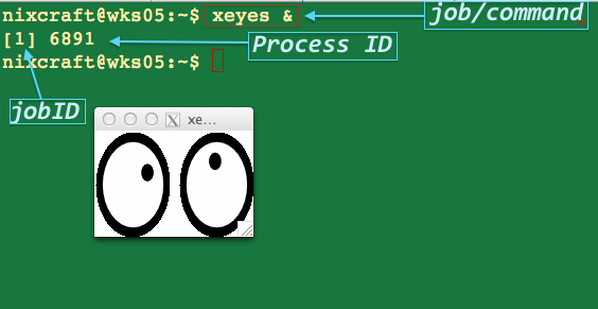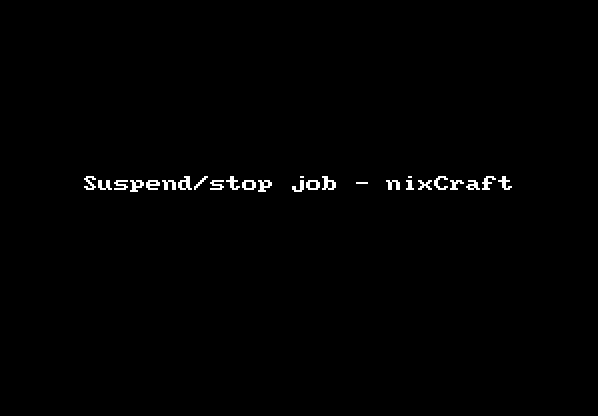mirror of
https://github.com/LCTT/TranslateProject.git
synced 2025-01-04 22:00:34 +08:00
285 lines
13 KiB
Markdown
285 lines
13 KiB
Markdown
10个 Linux/Unix下 Bash和KSH shell 的作业控制实例
|
||
================================================================================
|
||

|
||
|
||
Linux 和 Unix 属于多任务的操作系统,也就是说一个系统在同一时间段内能运行多重任务(进程)。在这个新的博客系列,我将会列出相关的 Linux和Unix作业控制的命令,你可以通过这些命令在 Bash 或 Korn 还有 POSIX shell 下实现执行多重任务。
|
||
|
||
### 什么是作业控制?###
|
||
|
||
作业控制不过是能够停止/挂起(stop/suspend)正在执行的进程(命令)也可以继续/唤醒(continue/resume)你需要的每一个进程来执行。这完全可以用你的操作系统和类似 bash/ksh 或 POSIX shell 完成。
|
||
|
||
### 谁提供给了作业控制的设施条件 ###
|
||
|
||
Bash / Korn shell,或者是 POSIX shell 提供给了作业控制的设施条件。
|
||
|
||
### 跟作业表打个招呼吧 ###
|
||
|
||
你的 shell 会留有一张当前作业的表单,称为作业表。当你键入命令时,shell 会给它分配一个 jobID(也称作 JOB_SPEC)。一个 jobID 或 JOB_SPEC只是很小的整数数值。
|
||
|
||
#### #1: 创建你的首个 Linux/Unix 作业(job) ####
|
||
|
||
我要运行一个名为 xeyes 的命令,它会在屏幕上显示两个椭圆的眼睛,输入:
|
||
$ xeyes &
|
||
|
||
输出样例:
|
||
|
||
[][4]
|
||
*Fig.01: 在后台运行 xeyes 命令*
|
||
|
||
我使用&符号让一个 job 在后台运行。shell 会打印一行信息类似如下:
|
||
|
||
[1] 6891
|
||
|
||
在这个例子中,有两个数字输出,分别表示:
|
||
|
||
- [1] : 在后台执行的 xeyes 任务的作业号为 1。
|
||
- 6891 : 作业1的进程ID。
|
||
|
||
我在多执行一些 job:
|
||
|
||
## 启动一个文本编辑器,X 的系统负载显示,和 sleep 命令 ##
|
||
gedit /tmp/hello.c &
|
||
xload &
|
||
sleep 100000 &
|
||
|
||
#### #2: 列出当前的jobs ####
|
||
|
||
To [see the status of active jobs in the current shell][1], type:
|
||
|
||
$ jobs
|
||
$ jobs -l
|
||
|
||
输出样例:
|
||
|
||
[1] 9379 Running xeyes &
|
||
[2] 9380 Running gedit /tmp/hello.c &
|
||
[3]- 9420 Running xload &
|
||
[4]+ 9421 Running sleep 100000 &
|
||
|
||
A brief description of each field is given below:
|
||
|
||
(注:表格部分,这样发表出来应该会方便看一点)
|
||
<table border="1"><tbody><tr><th>字段</th><th>值</th><th>描述</th><th>示例</th></tr><tr><td>1</td><td>[1]</td><td><strong>jobID</strong> 或 <strong>JOB_SPEC</strong> - 工作号要与fg, bg, wait, kill和其他shell命令一起使用。你必须在工作号前缀添加一个百分号。(<kbd><strong>%</strong></kbd>).<br>加号 (<kbd>+</kbd>) 标识着默认的或是现在的 job。<br>减号 (<kbd>-</kbd>) 标识着先前的 job。</td><td><kbd>%1</kbd><br><kbd>fg %1</kbd><br><kbd>kill %2</kbd></td></tr><tr><td>2</td><td>9379</td><td><strong>进程 ID</strong> - 系统自动为每个进程创建并分配地独有的身份标志号。</td><td>kill 9379</td></tr><tr><td>3</td><td>Running</td><td><strong>状态</strong> - 关于 job 的状态:<br><kbd><strong>Running</strong></kbd> - 该 job 正在运行,还没有被外部信号挂起。<br><kbd><strong>Stopped</strong></kbd> - 该 job 已经被挂起。<br></td><td>N/A</td></tr><tr><td>4</td><td>xeyes &</td><td><strong>command</strong> - 由shell给出的命令。</td><td>script &<br>firefox url&</td></tr></tbody></table>
|
||
|
||
你也可以用 ps 命名列出当前系统正在运行的进程:
|
||
|
||
$ ps
|
||
|
||
#### #3: 停止或挂起正在运行的jobs ####
|
||
|
||
按下[Ctrl]-[Z]键或使用[kill 命令][2],如下所示:
|
||
|
||
kill -s stop PID
|
||
|
||
举个例子,启动[ping 命令][3],然后用 Ctrl-Z 键触发停止 ping 命令的job:
|
||
|
||
[][5]
|
||
*Animated gif 01: 挂起 ping 命令的 job*
|
||
|
||
#### #4: 在前台恢复 挂起的/停止的 job ####
|
||
|
||
让我们[恢复处于停止状态下的 job 回到前台运行][6],要实现这个目标当前 job 必须借助[fg 命令][7]。具体语法如下:
|
||
|
||
## ping 命令的作业号的值为5 ##
|
||
fg %5
|
||
|
||
我也可以规定命令行开端符合字符串"ping"的 job[译注:不能出现不明确的字符串,例如如果后台有两个 vim 进程而你敲入 fg %vim 会报错。]:
|
||
|
||
## %String ##
|
||
fg %ping
|
||
|
||
输出样例:
|
||
|
||
64 bytes from www.cyberciti.biz (75.126.153.206): icmp_req=3 ttl=53 time=265 ms
|
||
64 bytes from www.cyberciti.biz (75.126.153.206): icmp_req=4 ttl=53 time=249 ms
|
||
64 bytes from www.cyberciti.biz (75.126.153.206): icmp_req=5 ttl=53 time=267 ms
|
||
^C
|
||
|
||
#### #5: 在后台恢复 挂起/停止状态的 job ####
|
||
|
||
在这个例子中,我将要使用[yum 命令][8]更新所有安装在 Redhat 或 CentOS Linux 生产服务器上的软件包并置于后台作业。
|
||
|
||
# yum -y update &>/root/patch.log &
|
||
|
||
然而,由于一些原因(例如,过载问题)我决定停止这个 job 20分钟:
|
||
|
||
# kill -s stop %yum
|
||
|
||
输出样例:
|
||
|
||
[7]+ Stopped yum -y update &>/root/patch.log &
|
||
|
||
#### 用 bg 重启停止在后台的 yum 进程 ####
|
||
|
||
现在,我将要[恢复停止的 yum -y update &>/root/patch.log & job][9],键入:
|
||
|
||
# bg %7
|
||
|
||
或者:
|
||
|
||
# bg %yum
|
||
|
||
输出样例:
|
||
|
||
[7]+ yum -y update &>/root/patch.log &
|
||
|
||
#### #6: 杀死作业/进程 ####
|
||
|
||
杀死[yum 命令][10]进程,输入如下[kill 命令][11]及其作业号 7:
|
||
|
||
# kill %7
|
||
|
||
或者
|
||
|
||
# kill pid
|
||
|
||
输出样例:
|
||
|
||
[7]+ Terminated yum -y update &>/root/patch.log &
|
||
|
||
在 Linux/FreeBSD/OS X Unix 下你可以[使用 killall 命令通过名字杀死进程或是 jobID 而不是通过 PID][12]
|
||
|
||
#### #7 为什么当我登出后 shell 会清除我的所有后台 jobs ####
|
||
|
||
在这个例子中,我将会启动 pdfwriter.py 来生成[这个站点][13]散装地 pdf 文件:
|
||
|
||
~/scripts/www/pdfwriter.py --profile=faq --type=clean --header=logo\
|
||
--footer-left "nixCraft is GIT UL++++ W+++ C++++ M+ e+++ d-" \
|
||
--footer-right "Page [of] of [total]" &
|
||
|
||
一旦当我登出shell时,pdfwriter.py 作业就会被我的 shell 杀死。为了克服这个问题需要使用[shell的内置命令 disown 来告诉 shell 不要发送 HUP 信号][14],键入:
|
||
|
||
$ ~/scripts/www/pdfwriter.py --profile=faq .... &
|
||
$ disown
|
||
$ exit
|
||
|
||
#### #8 使用一个名为 nohup 的外部命令阻止在登出时杀死 job ####
|
||
|
||
你也可以使用[nohup 命令在你退出 shell 后执行 jobs][15]:
|
||
|
||
$ nohup ~/scripts/www/pdfwriter.py --profile=faq .... &
|
||
$ exit
|
||
|
||
#### #9: 查找最后 job 的 PID ####
|
||
|
||
为了查找最近在后台执行的(异步)命令的进程ID,可使用 bash shell 的特殊参数 $!
|
||
|
||
$ gedit foo.txt &
|
||
$ echo "最近在后台执行的job 的PID - $!"
|
||
|
||
输出样例:
|
||
|
||
最近在后台执行的job 的PID - 9421
|
||
|
||
#### #10: 等候 job 完成 ####
|
||
|
||
wait 命令会等候给予的进程ID 或 作业ID,然后报告它的终止状态。语法如下:
|
||
|
||
/path/to/large-job/command/foo &
|
||
wait $!
|
||
/path/to/next/job/that-is-dependents/on-foo-command/bar
|
||
|
||
这是我的一个工作脚本:
|
||
|
||
#!/bin/bash
|
||
# A shell script wrapper to create pdf files for our blog/faq section
|
||
########################################################################
|
||
# init() - Must be run first
|
||
# Purpose - Create index file in $_tmp for all our wordpress databases
|
||
########################################################################
|
||
init(){
|
||
_php="/usr/bin/php"
|
||
_phpargs="-d apc.enabled=0"
|
||
_base="~/scripts"
|
||
_tmp="$_base/tmp"
|
||
_what="$1"
|
||
for i in $_what
|
||
do
|
||
[[ ! -d "$_tmp/$i" ]] && /bin/mkdir "$_tmp/$i"
|
||
$_php $_phpargs -f "$_base/php/rawsqlmaster${i}.php" > "$_tmp/$i/output.txt"
|
||
done
|
||
}
|
||
|
||
#####################################################
|
||
# Without index file, we can out generate pdf files
|
||
#####################################################
|
||
init blog
|
||
|
||
###########################################################
|
||
# Do not run the rest of the script until init() finished
|
||
###########################################################
|
||
wait $!
|
||
|
||
## Alright, create pdf files
|
||
~/scripts/www/pdfwriter.py --profile=blog --type=clean --header=logo\
|
||
--footer-left "nixCraft is GIT UL++++ W+++ C++++ M+ e+++ d-" \
|
||
--footer-right "Page [of] of [total]"
|
||
|
||
#### Linux 和 Unix 作业控制命令总结列表 ####
|
||
|
||
<table border="1"><tbody><tr><th>命令</th><th>描述</th><th>示例</th></tr><tr><td><kbd><strong>&</strong></kbd></td><td>将 job 置入后台</td><td><kbd>命令 &</kbd></td></tr><tr><td><kbd><strong>%n</strong></kbd></td><td>设置作业号为 n (数字)的 job</td><td><kbd>命令 %1</kbd></td></tr><tr><td><kbd><strong>%Word</strong></kbd></td><td>引用命令行开端包含 Word 的 job</td><td><kbd>命令 %yum</kbd></td></tr><tr><td><kbd><strong>%?Word</strong></kbd></td><td>引用命令行包含 Word 的 job</td><td><kbd>命令 %?ping</kbd></td></tr><tr><td><kbd><strong>%%</strong></kbd><br><kbd><strong>%+</strong></kbd></td><td>引用当前 job</td><td><kbd>kill %%<br>kill %+</kbd></td></tr><tr><td><kbd><strong>%-</strong></kbd></td><td>引用先前 job</td><td><kbd>bg %-</kbd></td></tr><tr><td><kbd><strong>CTRL-Z</strong><br><kbd><strong>kill -s stop jobID</strong></kbd></kbd></td><td>挂起或停止 job</td><td><kbd>kill -s stop %ping</kbd></td></tr><tr><td><kbd><strong>jobs</strong><br><kbd><strong>jobs -l</strong></kbd></kbd></td><td>列出活动的 jobs</td><td><kbd>jobs -l</kbd></td></tr><tr><td><kbd><strong>bg</strong></kbd></td><td>将 jobs 置入后台</td><td><kbd>bg %1<br>bg %ping</kbd></td></tr><tr><td><kbd><strong>fg</strong></kbd></td><td>将 job 置入前台</td><td><kbd>fg %2<br>fg %apt-get</kbd></td></tr></tbody></table>
|
||
|
||
#### 关于 shell 内置命令和外部命令的小注 ####
|
||
|
||
运行下面的 type 命令找出给予命令是否属于内部或外部的。
|
||
|
||
type -a fg bg jobs disown
|
||
|
||
输出样式:
|
||
|
||
fg is a shell builtin
|
||
fg is /usr/bin/fg
|
||
bg is a shell builtin
|
||
bg is /usr/bin/bg
|
||
jobs is a shell builtin
|
||
jobs is /usr/bin/jobs
|
||
disown is a shell builtin
|
||
|
||
在几乎所有情况下,你都需要使用 shell 的内置命令。所有外部命令例如 /usr/bin/fg 或 /usr/bin/jobs 工作在一个不同的 shell 环境下,而不能用在父 shell 的环境下。
|
||
|
||
#### 总结 ####
|
||
|
||
我希望你能喜欢这篇博文系列([rss 订阅][16]),我建议你阅读下面的更多信息:
|
||
|
||
- 在我们的 faq 章节查阅有关进程管理的文章[disoen 命令示例][17],[jobs 命令示例][18],[bg 命令示例][19],和[fg 命令示例][20]。
|
||
- Man pages [bash(1)][21], [ksh(1)][22], [ps(1)][23], [kill(1)][24]
|
||
- [Korn shell (ksh93) 文档][25].
|
||
- [NU bash shell 文档][26].
|
||
|
||
我会计划在这个系列添加更多深入的教程。若果你需要看到具体的主题,请在下方评论让我知道。
|
||
|
||
--------------------------------------------------------------------------------
|
||
|
||
via: http://www.cyberciti.biz/howto/unix-linux-job-control-command-examples-for-bash-ksh-shell/
|
||
|
||
译者:[Luoxcat](https://github.com/Luoxcat) 校对:[校对者ID](https://github.com/校对者ID)
|
||
|
||
本文由 [LCTT](https://github.com/LCTT/TranslateProject) 原创翻译,[Linux中国](http://linux.cn/) 荣誉推出
|
||
|
||
[1]:http://www.cyberciti.biz/faq/unix-linux-jobs-command-examples-usage-syntax/
|
||
[2]:http://www.cyberciti.biz/faq/unix-kill-command-examples/
|
||
[3]:http://www.cyberciti.biz/faq/unix-ping-command-examples/
|
||
[4]:http://www.cyberciti.biz/howto/unix-linux-job-control-command-list-for-bash-ksh-shell/attachment/run-xeyes-command-in-background/
|
||
[5]:http://www.cyberciti.biz/howto/unix-linux-job-control-command-list-for-bash-ksh-shell/attachment/suspend-unix-job-command/
|
||
[6]:http://www.cyberciti.biz/faq/unix-linux-fg-command-examples-usage-syntax/
|
||
[7]:http://www.cyberciti.biz/faq/unix-linux-fg-command-examples-usage-syntax/
|
||
[8]:http://www.cyberciti.biz/faq/rhel-centos-fedora-linux-yum-command-howto/
|
||
[9]:http://www.cyberciti.biz/faq/unix-linux-bg-command-examples-usage-syntax/
|
||
[10]:http://www.cyberciti.biz/faq/rhel-centos-fedora-linux-yum-command-howto/
|
||
[11]:http://www.cyberciti.biz/faq/unix-kill-command-examples/
|
||
[12]:http://www.cyberciti.biz/faq/unix-linux-killall-command-examples-usage-syntax/
|
||
[13]:http://www.cyberciti.biz/faq/
|
||
[14]:http://www.cyberciti.biz/faq/unix-linux-disown-command-examples-usage-syntax/
|
||
[15]:http://www.cyberciti.biz/tips/nohup-execute-commands-after-you-exit-from-a-shell-prompt.html
|
||
[16]:http://www.cyberciti.biz/tutorials/practical-unixlinux-series/feed/
|
||
[17]:http://www.cyberciti.biz/faq/unix-linux-disown-command-examples-usage-syntax/
|
||
[18]:http://www.cyberciti.biz/faq/unix-linux-jobs-command-examples-usage-syntax/
|
||
[19]:http://www.cyberciti.biz/faq/unix-linux-bg-command-examples-usage-syntax/
|
||
[20]:http://www.cyberciti.biz/faq/unix-linux-fg-command-examples-usage-syntax/
|
||
[21]:http://www.manpager.com/linux/man1/bash.1.html
|
||
[22]:http://www.manpager.com/linux/man1/ksh.1.html
|
||
[23]:http://www.manpager.com/linux/man1/ps.1.html
|
||
[24]:http://www.manpager.com/linux/man1/kill.1.html
|
||
[25]:http://www2.research.att.com/sw/download/man/man1/ksh.html
|
||
[26]:https://www.gnu.org/software/bash/manual/bashref.html
|